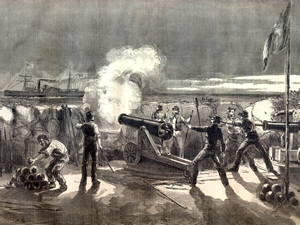Sun 9 Jan, 2011
The Civil War begins
Comment now Filed under: Civil War 150th, HistoryTags: Charleston S.C., Civil War sesquicentennial, Fernando Wood, Fort Sumter, Tracing Center, U.S. Civil War
 Today is the 150th anniversary of the outbreak of the U.S. Civil War.
Today is the 150th anniversary of the outbreak of the U.S. Civil War.
On January 9, 1861, shore batteries in Charleston, South Carolina opened fire on the steamer Star of the West as that merchant ship attempted to reach Fort Sumter with fresh troops and supplies. The Star of the West was hit and forced to retreat, setting the stage for a wider conflict to break out in April, when Fort Sumter would run out of food and be forced to surrender if not reinforced.
South Carolina had declared secession from the Union on December 20, and it would be joined this day by Mississippi. Five other southern states would declare their secession before the end of the month, but the formation of the Confederate States of America would not come until after that, and Lincoln would not be inaugurated until March.
The march to war was neither as inevitable, nor as simple, as these events may seem from the perspective of a century and a half later. Delaware had voted six days earlier not to secede from the Union, establishing that the border states, while bitterly divided, would formally side with the national government. And in New York City, just two days earlier, Mayor Fernando Wood had proposed to the city council that the city itself secede to become an independent city-state; he reasoned that New York City would be better off without the control of Albany or Washington and with the freedom to continue the lucrative cotton trade with the slave states. Wood’s proposal, in particular, illustrates that the North was not as opposed to southern slavery, nor as free from complicity in slavery itself, as we may often think.
The sesquicentennial (or 150th anniversary) of the Civil War over the next five years represents a major opportunity for all Americans to either embrace the tired myths of the past, or to challenge this public memory with a fresh understanding of the role of slavery and race in the Civil War and in our society and politics ever since. This task will be a major project for those of us at the Tracing Center between now and 2015, and I’ll have more to say on this topic in the coming days and years.